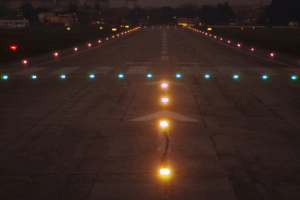Airport Lighting Control and Monitoring Systems (ALCMS) play a crucial role in optimizing the efficiency, safety, and overall functionality of modern airports around the world. These systems go beyond providing illumination and are, in reality, sophisticated networks of technologies that manage and control various lighting elements across the airport infrastructure while supporting the global aviation network.
The Fundamentals Of Airport Lighting Control And Monitoring Systems
ALCMS is made up of five fundamental components:
Runway Lighting
Runway lighting is a critical element of ALCMS, ensuring safe takeoffs and landings, especially during low visibility conditions. Precision approach path indicators (PAPI) and runway edge lights are controlled by the system to guide pilots and maintain optimal visibility.
Approach Lighting Systems (ALS)
Approach lighting systems are designed to aid pilots during the final approach phase. ALCMS controls the configuration and intensity of these lights, ensuring that pilots have a clear visual reference point as they approach the runway, contributing to safe and precise landings.
Taxiway Lighting
Taxiway lighting facilitates aircraft movement on the ground, preventing collisions and ensuring efficient taxiing between runways, terminals, and gates. The ALCMS manages the intensity and sequencing of taxi lights to guide pilots along designated paths.
Apron Lighting
ALCMS also manages apron floodlights, perimeter lighting, and other elements to ensure a well-lit apron area, enabling safe ground operations, including aircraft parking, loading, and unloading.
Terminal Building Lighting
Although they don’t directly impact runway illumination, interior and exterior lighting of terminal buildings are integrated into the ALCMS to create a comfortable and visually appealing environment for passengers, staff, and visitors.
How Does The Airport Lighting Control And Monitoring System Work?
Airport lighting control and monitoring systems seamlessly manage airport lighting components by controlling the sequencing and intensity of runway and taxiway lights, minimizing the risk of runway incursions. The ALCMS can also establish communication with aircraft systems, providing pilots with relevant information about current lighting configurations, runway conditions, and any operational updates. This communication enhances situational awareness and supports smooth transitions during various phases of flight.
Additionally, real-time updates can be provided to ground crews and air traffic controllers, keeping them apprised of changing situations that can affect air traffic. In the event of an emergency, ALCMS can be programmed to activate specific lighting configurations to guide emergency vehicles, assisting them in navigating the airport terrain and reaching critical areas efficiently when a swift and effective response is paramount.
Remote monitoring allows control tower operators to manage lighting systems from a centralized location, optimizing resource allocation and responding promptly to runway or taxiway status. This feature also enables maintenance teams to identify issues promptly and perform necessary repairs. To mitigate the risk of sudden system failures, ALCMS often incorporates redundancy and backup systems, ensuring continuous operation even when equipment malfunctions or power disruptions occur.
ALCMS can incorporate weather sensors that help adapt lighting conditions based on real-time weather data. During fog, rain, or snow, the system can adjust the intensity and configuration of lights to maintain visibility thresholds, ensuring safe aircraft movements.
Operational decision-making is facilitated by integrating and sharing real-time data with air traffic management systems. This feature contributes to a more coordinated approach to air traffic management, optimizing airport operations, minimizing delays, and predicting potential issues so management can proactively schedule maintenance.
The system also offers energy efficiency and better sustainability by using energy-efficient LED technology. LEDs consume less power, have longer lifespans, and contribute to reducing the environmental impact of airport operations. Additional energy is conserved through using ALCMS’s adaptive lighting functionality that dynamically adjusts lighting levels based on the presence of aircraft and ground activities, minimizing unnecessary illumination during periods of low activity.
Read More: Illuminating Sustainability: How Airport Lighting Technology Meets Sustainability Needs
Introducing Airport Lighting Company’s L-890 ALCMS Encompass
Our L-890 ALCMS Encompass is designed to simplify the control and monitoring of lighted visual aids. The system offers reliable, efficient performance, whether used for a general aviation airport that supports only a few operations in a day or a large commercial airport that caters to hundreds of operations on any given day.
This product undergoes rigorous testing and certification processes to ensure reliability and compliance with international aviation standards set by organizations such as the International Civil Aviation Organization (ICAO) and the Federal Aviation Administration, delivering the utmost operational precision, efficiency, and safety.
Call Airport Lighting Company for The Latest in Airport Lighting Technology
The Airport Lighting Company team is standing by to answer your questions about how our tech-based products can help improve the safety, reliability, and efficiency of your runways. Call 315-682-6460 for fast, friendly service you can count on.





